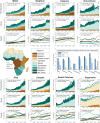An Africa-wide agricultural production database to support policy and satellite-based measurement systems
- PMID: 40593880
- PMCID: PMC12215972
- DOI: 10.1038/s41597-025-05257-5
An Africa-wide agricultural production database to support policy and satellite-based measurement systems
Abstract
Agriculture remains a backbone of the African economy, contributing up to 70% of household income in rural areas. Yet crop yields across Africa are rising at a slower rate than the global average. Currently, strategies to improve agricultural productivity are limited by the availability of granular, accurate, and spatially-extensive data. These disaggregated statistics are required to understand how crop yields respond to climate variability, climate extremes, and agronomic practices. Here, we present GROW-Africa, a database that includes n = 535,844 georeferenced observations of crop yields across Africa focusing on 25 key crops including maize, sorghum, cassava, groundnuts, cowpeas, rice, yams, and millet. The database assimilates observations from a range of spatial scales, from regional government statistics, to household farmer surveys, to plot-level crop cuts. We use co-located observations to identify sources of bias and error in these varied data types. Finally, we demonstrate how the GROW-Africa database can be used to train remote sensing algorithms to produce continuous maps of crop yields across Africa.
© 2025. The Author(s).
Conflict of interest statement
Competing interests: The authors declare no competing interests.
Figures















References
-
- Carletto, C., Jolliffe, D. & Banerjee, R. The Emperor has no data! Agricultural statistics in sub-Saharan Africa. World Bank Working Paper565 (2013).
-
- Ligon, E. A. & Sadoulet, E. Estimating the effects of aggregate agricultural growth on the distribution of expenditures. CUDARE Working Papers (2011).
-
- Liu, J., Wennberg, P. O., Parazoo, N. C., Yin, Y. & Frankenberg, C. Observational constraints on the response of high-latitude northern forests to warming. AGU Advances1, e2020AV000228 (2020).
-
- Wang, Y. et al. Elucidating climatic drivers of photosynthesis by tropical forests. Global Change Biology (2023). - PubMed
LinkOut - more resources
Full Text Sources

